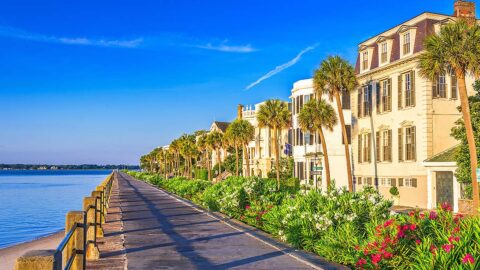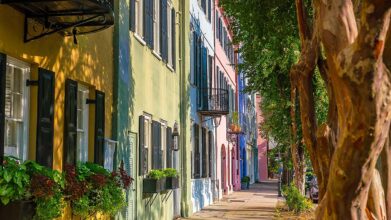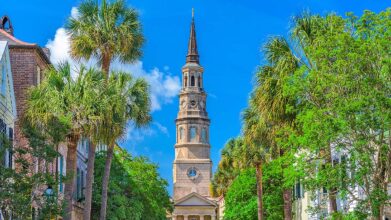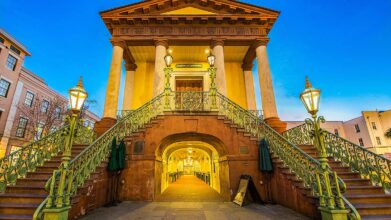The Battery

Complete Guide The Battery in Charleston
Battery Park is one of Charleston’s most historic waterfront areas, offering sweeping views of the harbor. Once a strategic military defense site, it played a key role in protecting the city from naval attacks during the Civil War. Today, the area is known for its grand antebellum mansions, tree-lined streets, and White Point Garden, a park filled with historic cannons and monuments. The combination of history and scenic beauty makes Battery Park one of Charleston’s most iconic locations.
History of The Battery
The Battery sits at the southern tip of the Charleston peninsula and holds a meaningful place in the city’s history. The name refers to both the raised seawall and promenade along the waterfront, as well as the adjacent White Point Garden. Its story begins with defense. In Charleston’s early days, this area was protected by simple earthen fortifications that eventually became a stone seawall. These upgrades made it a key part of the city’s defense system during both the Revolutionary War and the Civil War. From this point, observers witnessed the first shots fired at Fort Sumter in 1861.
Over time, The Battery evolved from a military stronghold into one of Charleston’s most beloved public spaces. Wealthy families built elegant homes along the waterfront, and the walkway became a popular place to stroll and take in the view. The oak trees that line the garden provide welcome shade during warm months and have become one of its most photographed features. Many of the cannons on display in White Point Garden were recovered from Civil War battle sites and are marked with plaques describing their origin. In addition to its military relics, visitors will also find memorials dedicated to notable figures and events that helped shape Charleston’s identity. Today, White Point Garden is home to historic cannons, mortars, and monuments that reflect the area’s past. The Battery remains a powerful symbol of Charleston’s history, combining architectural beauty with centuries of stories.
Charleston Battery Facts
- White Point Garden, located within The Battery, features a collection of historic cannons that speak to the area’s military past. Many of these cannons were recovered from Civil War battlefields and naval vessels, offering a physical link to Charleston’s wartime history. Informative plaques help identify their origin and significance.
- The grand houses that line The Battery offer a look at Charleston’s antebellum architecture and history. These homes were built by some of the city’s wealthiest families in the 1800s and feature signature elements like large piazzas, intricate ironwork, and Greek Revival columns. Many are still privately owned and meticulously preserved.
- During the Civil War, The Battery served as a location from which the bombardment of Fort Sumter could be observed. While it wasn’t the primary site of active combat, its strategic position gave residents and military personnel a clear line of sight to the conflict that sparked the war.
- Given Charleston’s maritime history, stories of pirates and their connection to the harbor are associated with the area. Legends of Blackbeard and Stede Bonnet, both active along the South Carolina coast, are part of the city’s colorful past. Some historians believe pirates may have once anchored near this shoreline.
- The defenses at The Battery changed over centuries, evolving from basic earthen structures to a strong seawall. These improvements reflected the city’s growing need for coastal protection as naval threats became more advanced. The final stone wall was completed in the early 1800s and has withstood multiple hurricanes and tidal surges.
- White Point Garden transitioned from a military space into a public park for everyone to enjoy. Once used for mounting cannons and storing munitions, the garden is now a peaceful retreat with shaded walkways, flowerbeds and benches beneath centuries-old oak trees.
- In addition to cannons, The Battery features several monuments that remember key events and individuals in Charleston’s story. These include tributes to Confederate defenders, memorials to fallen sailors, and statues commemorating the city’s role in early American history.
Know Before You Go
- Waterfront Views and History: Expect impressive views of Charleston Harbor, including Fort Sumter, Castle Pinckney, and the USS Yorktown, which sits across the water at Patriots Point. The Battery is rich with history, and visitors will see antebellum mansions lining the walkway, along with remnants of old defensive structures that once helped protect the city.
- Waterfront Views and History: Expect impressive views of Charleston Harbor, including Fort Sumter, Castle Pinckney, and the USS Yorktown, which sits across the water at Patriots Point. The Battery is rich with history, and visitors will see antebellum mansions lining the walkway, along with remnants of old defensive structures that once helped protect the city.
- Hours of Operation: The Battery and White Point Garden are public spaces and generally open to visitors every day. While there are no official hours posted, it is a good idea to check the City of Charleston website in case of special events, weather-related closures or maintenance updates.
- Ideal Visit Times: Spring and fall usually offer the most comfortable weather for walking along The Battery. These seasons bring cooler temperatures, blooming flowers and clearer skies. Visiting in the early morning or late afternoon can also provide softer light and a more peaceful atmosphere.
- Getting There and Parking: Parking near The Battery can be challenging during weekends and holidays. Free two-hour parking is available on South Battery, and metered spaces may be open along Murray Boulevard. Several parking garages are located downtown, although they may require a short walk to reach the waterfront. Ride-sharing services such as Uber and Lyft are a convenient alternative, with drop-off points commonly found near White Point Garden or the intersection of King Street and South Battery.
- Visitor Volume: The Battery is one of Charleston’s most popular landmarks and often sees heavy foot traffic during the spring and summer seasons. For a quieter experience, consider visiting on a weekday or during the winter months. Even during slower times, the views and atmosphere remain just as impressive.
Things To Do Near The Battery in Charleston
Old Town Trolley Tours
A visit to The Battery in Charleston offers a meaningful look into the city’s layered history. Walking along the seawall or through White Point Garden connects you to stories of wartime defense, architectural legacy, and daily life in one of the South’s most historic cities. Pairing your visit with a ride aboard Old Town Trolley Tours® helps you understand how The Battery fits into Charleston’s larger story. The fully narrated tour gives helpful context about nearby landmarks and provides an easy way to explore more of the city without worrying about parking or directions. Together, these experiences offer a well-rounded introduction to Charleston’s charm and past.
Enjoy Scenic Views
Take in sweeping views of Charleston Harbor, including Fort Sumter, Castle Pinckney, and the meeting point of the Ashley and Cooper Rivers. You might spot sailboats drifting by or even catch a glimpse of dolphins playing near the seawall. This view has drawn visitors for generations and continues to be one of the highlights of a walk along The Battery.
Stroll Along the Seawall
Walk the historic seawall promenade that gives The Battery its name. The sea breeze, the sound of the water and the line of elegant homes create a peaceful and scenic atmosphere. The promenade is a favorite spot for photos, especially near the curve where the walkway meets White Point Garden.
Explore White Point Garden
White Point Garden is a shaded public park filled with historic cannons, mortars, and military monuments. The garden also features memorials dedicated to sailors, soldiers, and notable figures in Charleston’s history. Benches beneath the sprawling oak trees offer a quiet place to relax and take in the surroundings.
Discover Charleston’s Civil War History
The Battery offers insight into Charleston’s role in the Civil War and other key historical moments. Informational plaques throughout White Point Garden help explain the area’s military significance, from early colonial defenses to its connection with the first shots fired at Fort Sumter. This part of Charleston invites visitors to reflect on the events that shaped the city and the nation.
Rainbow Row
Rainbow Row is a series of 13 historic houses on East Bay Street, just a short walk from The Battery. Known for their pastel-colored facades, these 18th-century homes are among the most photographed landmarks in Charleston. The bright colors were added during 20th-century restorations and have become a defining feature of the city’s architectural charm. While they are private residences, visitors can admire their unique style and snap a photo from the sidewalk.
Edmondston-Alston House
Located on East Battery, the Edmondston-Alston House is one of the few historic homes open to the public in this area. Built in 1825, it showcases Federal and Greek Revival architecture and offers guided tours of its preserved interior. Visitors can view original furnishings, family heirlooms, and period portraits. From the second-floor piazza, you’ll also get one of the best views of Charleston Harbor, including the site of the Civil War’s opening shots.
Charleston Waterfront Park
This public park stretches along the Cooper River and is a favorite gathering spot for locals and visitors alike. Built on the site of former shipping wharves, it opened in 1990 and connects Charleston’s past with its present. The park features shaded walking paths, wooden piers, and the famous Pineapple Fountain. You’ll also find swings, benches, wide views of the harbor, Castle Pinckney and passing ships. It’s a great place to relax after walking The Battery.
Take a Harbor Tour
Seeing The Battery from the water offers a completely different perspective on Charleston’s historic waterfront. Several local companies offer boat tours that pass by the peninsula, with guides pointing out key landmarks along the way. These tours often include views of Fort Sumter, the USS Yorktown, and the Ravenel Bridge. Many also share stories about the city’s maritime past, including shipbuilding, trade and the impact of war on the harbor.
FAQs
How long do you need to visit King Street?
The main walkway along The Battery, often called the High Battery, runs for about 1.2 miles. A more direct walk from the curve of the seawall near White Point Garden to the northern end at Water Street typically takes around 15 to 20 minutes at a relaxed pace. The entire area is pedestrian-friendly, with benches and shaded areas along the way.
How long is the walk on The Battery in Charleston, SC?
The main walkway along The Battery, often called the High Battery, runs for about 1.2 miles. A more direct walk from the curve of the seawall near White Point Garden to the northern end at Water Street typically takes around 15 to 20 minutes at a relaxed pace. The entire area is pedestrian-friendly, with benches and shaded areas along the way.
What is The Battery in Charleston famous for?
The Battery in Charleston is famous for several things:
- Scenic Harbor Views: It offers panoramic vistas of Charleston Harbor, including Fort Sumter, Castle Pinckney, and the meeting point of the Ashley and Cooper rivers.
- Historical Significance: The area is steeped in history, having served as a crucial defensive point for Charleston from the colonial era through the Civil War.
- Antebellum Architecture: The promenade is lined with grand and impressive antebellum mansions, showcasing the city’s rich architectural heritage.
- White Point Garden: This park within The Battery features a collection of historic cannons, mortars, and monuments that tell stories of past conflicts and significant figures.
Are there any events held at The Battery in Charleston?
Yes, The Battery and White Point Garden are occasionally used for private events such as weddings, photo sessions and local walking tours. While the Charleston Battery soccer team is unrelated and plays at Patriots Point Stadium, the area around The Battery often plays a role in larger citywide festivals and historic home tours, especially during the spring Charleston Festival.




